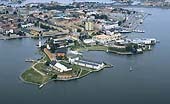In the LIMA exhibition 2015, Malaysia announced that the Naval Strike Missile had won the contract to fulfil the Royal Malaysian Navy'sSecond Generation Patrol Vessel's anti-ship missile requirement.[17][18]
Design and features[edit]
The state-of-the-art design and use of composite materials is meant to give the missile sophisticated stealth capabilities. The missile will weigh slightly more than 400 kg (880 lb) and have a range of at least 185 km (100 nm). NSM is designed for littoral waters ("brown water") as well as for open sea ("green and blue water") scenarios. The usage of a high strength titanium alloy blast/fragmentation warhead from TDW is in line with the modern lightweight design and features insensitive high-explosive II. Warhead initiation is by a void-sensing Programmable Intelligent Multi-Purpose Fuze designed to optimise effect against hard targets.[19]
Like its Penguin predecessor, NSM is able to fly over and around landmasses, travel in sea skim mode, and then make random manoeuvres in the terminal phase, making it harder to stop by enemy countermeasures. While the Penguin is a yaw-to-turn missile, NSM is based on bank-to-turn flight (see Yaw (flight) and flight control).
The target selection technology provides NSM with a capacity for independent detection, recognition, and discrimination of targets at sea or on the coast. This is possible by the combination of an imaging infrared (IIR) seeker and an onboard target database. NSM is able to navigate by GPS, inertial and terrain reference systems.
After being launched into the air by a solid rocket booster which is jettisoned upon burning out, the missile is propelled to its target in high subsonic speed by a turbojet sustainer engine—leaving the 125 kg multi-purpose blast/fragmentation warhead to do its work, which in case of a ship target means impacting the ship at or near the water line.

